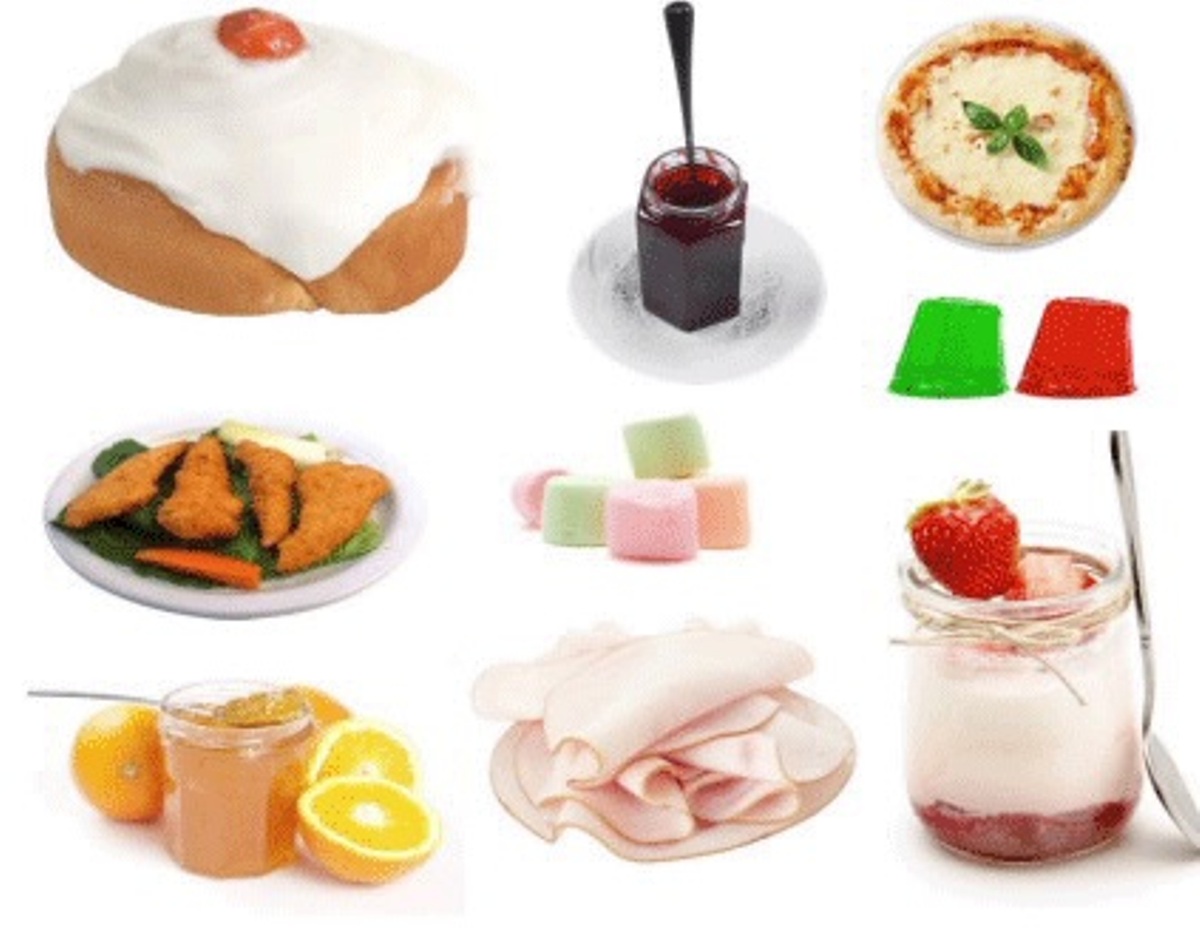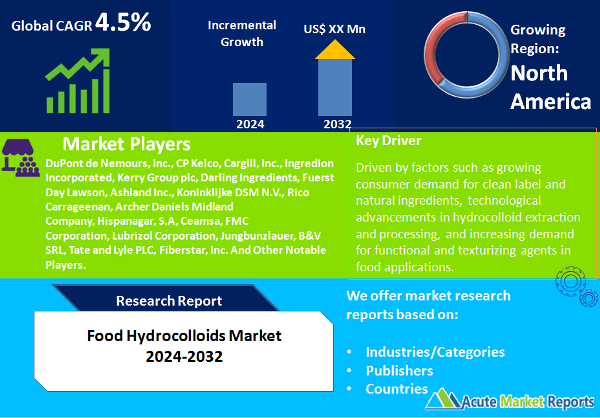
The food hydrocolloids market is expected to grow at a CAGR of 4.5% during the forecast period of 2024 to 2032, driven by factors such as growing consumer demand for clean label and natural ingredients, technological advancements in hydrocolloid extraction and processing, and increasing demand for functional and texturizing agents in food applications. However, regulatory challenges and compliance issues pose significant constraints to market expansion, necessitating transparency, traceability, and adherence to stringent quality standards by manufacturers. Despite intense competition among key players, opportunities for market growth and innovation abound, driven by evolving consumer preferences, technological advancements, and strategic collaborations. Overall, the food hydrocolloids market is expected to witness sustained growth and transformation in the forecast period, driven by its essential role in enhancing the sensory attributes, stability, and nutritional profile of food and beverage products.
Drivers
1. Growing Emphasis on Clean Label and Natural Ingredients: Consumer demand for clean-label products has intensified in recent years, prompting food manufacturers to seek natural alternatives to traditional additives and stabilizers. This trend has significantly contributed to the increasing adoption of plant-based hydrocolloids derived from sources such as guar gum, locust bean gum, and carrageenan. These plant-derived hydrocolloids offer multifunctional properties, including thickening, gelling, and stabilizing, making them suitable for a wide range of applications in the food industry. Moreover, the rising consumer awareness regarding the health benefits of natural ingredients has fueled the demand for hydrocolloids free from synthetic additives and allergens. As a result, food manufacturers are reformulating their products to incorporate clean-label hydrocolloids, driving market growth and innovation in response to evolving consumer preferences.
2. Technological Advancements in Hydrocolloid Extraction and Processing: Advancements in extraction and processing technologies have expanded the scope of hydrocolloid utilization in the food industry, enabling manufacturers to overcome challenges related to functionality, solubility, and sensory attributes. Innovative techniques such as enzymatic hydrolysis, membrane filtration, and supercritical fluid extraction have enhanced the efficiency and yield of hydrocolloid extraction from various botanical and microbial sources. These technological advancements have facilitated the production of hydrocolloids with improved functionality and purity, meeting the stringent quality standards required for food applications. Additionally, advances in food processing equipment and machinery have optimized the incorporation of hydrocolloids into food formulations, enabling manufacturers to achieve desired texture and stability without compromising product quality or sensory experience. As technological innovation continues to drive process efficiencies and cost optimization in hydrocolloid production, the market is poised for sustained growth and expansion across diverse application segments.
3. Increasing Demand for Functional and Texturizing Agents in Food Applications: The growing consumer preference for functional foods and beverages has propelled the demand for hydrocolloids as key ingredients for texture modification, stabilization, and emulsification. Hydrocolloids play a critical role in enhancing the sensory attributes and mouthfeel of food products, contributing to improved palatability and consumer acceptance. In bakery and confectionery applications, hydrocolloids are utilized as thickeners, gelling agents, and moisture retention agents to optimize product texture, shelf life, and appearance. Similarly, in dairy and beverage formulations, hydrocolloids are employed to impart creaminess, viscosity, and stability, enhancing the overall sensory experience for consumers. Moreover, the versatility of hydrocolloids enables their use in a wide range of product categories, including sauces, dressings, frozen desserts, and meat analogs, catering to diverse consumer preferences and dietary requirements. As consumer demand for functional and indulgent food products continues to rise, the market for hydrocolloids is expected to witness robust growth and innovation, driven by their essential role in texture optimization and product differentiation.

Restraint
Regulatory Challenges and Compliance Issues: The food hydrocolloid market faces regulatory challenges and compliance issues related to the safety, labeling, and permissible usage levels of hydrocolloid additives in food products. Regulatory authorities impose strict guidelines and quality standards to ensure the safety and integrity of food ingredients, including hydrocolloids, which necessitate rigorous testing and documentation by manufacturers. Compliance with these regulations requires significant investment in research, testing, and quality assurance measures, posing a barrier to entry for small and medium-sized enterprises (SMEs) and startups in the hydrocolloid industry. Moreover, inconsistencies in regulatory frameworks across different geographies present logistical challenges for multinational companies operating in multiple markets, necessitating adaptation to varying regulatory requirements and labeling standards. Additionally, concerns regarding allergenicity, microbial contamination, and chemical residues associated with certain hydrocolloid sources further complicate regulatory compliance efforts, impacting market access and consumer confidence. As regulatory scrutiny intensifies, manufacturers must prioritize transparency, traceability, and compliance to navigate the complex regulatory landscape and maintain market competitiveness.
Market Segmentation Analysis
Market by Source Type
The food hydrocolloids market is segmented by source type into plant hydrocolloids, seaweed hydrocolloids, microbial hydrocolloids, animal hydrocolloids, and chemically modified hydrocolloids. In 2023, plant hydrocolloids emerged as the highest revenue-generating segment, driven by the widespread availability and diverse functionality of botanical sources such as guar gum, locust bean gum, and xanthan gum. Plant hydrocolloids offer advantages such as clean label appeal, allergen-free formulations, and versatile applications across various food categories, including bakery, dairy, and beverages.
Meanwhile, seaweed hydrocolloids exhibited the highest compound annual growth rate (CAGR) during the forecast period of 2024 to 2032, attributed to the increasing utilization of seaweed extracts such as agar, carrageenan, and alginate in functional food and nutraceutical applications. Seaweed hydrocolloids offer unique functionalities such as gelling, thickening, and stabilizing, making them suitable for plant-based and sustainable food formulations aligned with consumer preferences for natural and eco-friendly ingredients.
Market by Type
Market segmentation by type encompasses a wide range of hydrocolloid categories, including cellulose and derivatives, hemicellulose, pectin, exudate gums, mucilage gum, fructans, carrageenan, agar, xanthan gum, pullulan, gellan gum, chitin and chitosan, gelatin, and others. Among these, xanthan gum emerged as the highest revenue-generating segment in 2023, driven by its widespread applications as a thickener, stabilizer, and emulsifier in various food and beverage formulations. Xanthan gum offers advantages such as high viscosity, shear stability, and compatibility with a wide range of pH and temperature conditions, making it indispensable in products ranging from sauces and dressings to bakery goods and dairy alternatives. Conversely, pullulan exhibited the highest CAGR during the forecast period, fueled by its increasing adoption as a film-forming agent and encapsulation matrix in functional food, pharmaceutical, and cosmetic applications. Pullulan offers unique properties such as film transparency, oxygen barrier properties, and biocompatibility, making it ideal for the development of edible films, coatings, and controlled-release delivery systems.
Market by Application
Market segmentation by application highlights the diverse use of hydrocolloids across various food and beverage categories, including bakery and confectionery, meat and poultry, sauces and dressings, beverages, dairy products, frozen desserts, and others. In 2023, bakery and confectionery emerged as the highest revenue-generating segment, driven by the extensive use of hydrocolloids for texture optimization, moisture retention, and shelf-life extension in baked goods, confections, and snacks. Meanwhile, beverages exhibited the highest CAGR during the forecast period, fueled by the growing demand for functional and flavored beverages requiring stabilizers, emulsifiers, and suspension agents to enhance mouthfeel, appearance, and sensory appeal. Hydrocolloids such as carrageenan, pectin, and gum arabic are widely utilized in beverage formulations to prevent sedimentation, improve viscosity, and stabilize emulsions, catering to evolving consumer preferences for premium and indulgent beverage experiences.
Market by Function
Market segmentation by function encompasses various roles of hydrocolloids in food and beverage applications, including thickening, stabilizing, emulsifying, gelling, coating, and others. In 2023, thickening emerged as the leading revenue contributor, driven by the widespread use of hydrocolloids such as guar gum, carrageenan, and methylcellulose to impart viscosity and texture to sauces, soups, gravies, and dressings. Meanwhile, gelling exhibited the highest CAGR during the forecast period, attributed to the increasing demand for hydrocolloid-based gels and structured systems in desserts, confections, and plant-based meat analogs. Hydrocolloid gels offer advantages such as texture modulation, mouthfeel enhancement, and ingredient encapsulation, catering to consumer preferences for innovative and indulgent food experiences.
North America Remains the Global Leader
Geographic segmentation highlights regional trends and market dynamics, with notable variations in consumption patterns, regulatory frameworks, and consumer preferences. In 2023, North America emerged as the region with the highest revenue percentage in the food hydrocolloids market, driven by the presence of established food and beverage industries, robust research and development activities, and evolving consumer preferences for clean labels and functional ingredients. Meanwhile, Asia Pacific exhibited the highest compound annual growth rate (CAGR) during the forecast period, fueled by rapid urbanization, rising disposable incomes, and shifting dietary habits towards convenience foods and premium food products. The increasing demand for hydrocolloids in applications such as dairy alternatives, convenience snacks, and functional beverages is driving market growth in the Asia Pacific region, supported by investments in food technology, infrastructure, and distribution networks.
Market Competition to Intensify during the Forecast Period
The food hydrocolloids market is characterized by intense competition among key players striving to expand their market presence and gain a competitive edge through product innovation, strategic partnerships, and geographical expansion. Leading players such as DuPont de Nemours, Inc., CP Kelco, Cargill, Inc., Ingredion Incorporated, Kerry Group plc, Darling Ingredients, Fuerst Day Lawson, Ashland Inc., Koninklijke DSM N.V., Rico Carrageenan, Archer Daniels Midland Company, Hispanagar, S.A, Ceamsa, FMC Corporation, Lubrizol Corporation, Jungbunzlauer, B&V SRL, Tate and Lyle PLC and Fiberstar, Inc. dominate the market landscape, leveraging their extensive product portfolios, technological expertise, and global distribution networks to cater to diverse customer needs and preferences. These companies are focusing on research and development initiatives to introduce novel hydrocolloid formulations with enhanced functionality, sustainability, and cost-effectiveness, addressing emerging market trends and regulatory requirements. Additionally, strategic collaborations, mergers, and acquisitions are prevalent strategies adopted by key players to strengthen their market position, expand their product offerings, and diversify their revenue streams across different geographies and end-use industries. With increasing competition and evolving consumer preferences, innovation and differentiation are key drivers shaping the competitive landscape of the food hydrocolloids market, driving market growth and transformation in the forecast period from 2024 to 2032.
Historical & Forecast Period
This study report represents analysis of each segment from 2022 to 2032 considering 2023 as the base year. Compounded Annual Growth Rate (CAGR) for each of the respective segments estimated for the forecast period of 2024 to 2032.
The current report comprises of quantitative market estimations for each micro market for every geographical region and qualitative market analysis such as micro and macro environment analysis, market trends, competitive intelligence, segment analysis, porters five force model, top winning strategies, top investment markets, emerging trends and technological analysis, case studies, strategic conclusions and recommendations and other key market insights.
Research Methodology
The complete research study was conducted in three phases, namely: secondary research, primary research, and expert panel review. key data point that enables the estimation of Food Hydrocolloids market are as follows:
Market forecast was performed through proprietary software that analyzes various qualitative and quantitative factors. Growth rate and CAGR were estimated through intensive secondary and primary research. Data triangulation across various data points provides accuracy across various analyzed market segments in the report. Application of both top down and bottom-up approach for validation of market estimation assures logical, methodical and mathematical consistency of the quantitative data.
| ATTRIBUTE | DETAILS |
|---|---|
| Research Period | 2022-2032 |
| Base Year | 2023 |
| Forecast Period | 2024-2032 |
| Historical Year | 2022 |
| Unit | USD Million |
| Segmentation | |
Source Type
| |
Type
| |
Application
| |
Function
| |
|
Region Segment (2022-2032; US$ Million)
|
Key questions answered in this report